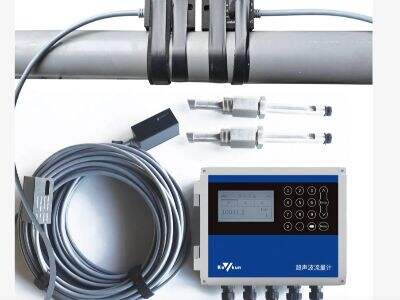A folyadékok áramlásának mérése a csövekben két típusú árammérőt használunk. Az elektromosmágneses árammérők és az ultrahangos árammérők a két típusú árammérő, amelyről beszélgetünk. Mindkét eszköz azt mondja meg, hogy mennyi folyadék áramlik a csövekben, de másféle eljárásokat alkalmaznak. Nézzük meg részletesebben, hogyan működik mindegyik árammérő, és mi különbözteti meg őket, valamint mi teszi hasznosaként.
Hogyan mérjük az áramlást?
Az elektromos áramlás-mérő egy speciális elektronikai eszköz, amelyet lassú sebességű vezetékes folyadékok, például víz áramlásának mérésekor használnak. Ahogy a folyadék halad át a csöves rendszerben, egy olyan jelenséget hoz létre, amit mágneses mezőként ismernak. Ez a erő, amelyet a folyadék mozgása alapján teremt. Az áramlásmérő belseje két érzékelőből áll, amelyeket elektrodáknak nevezünk, és ezeket a folyadékba helyezik, merőlegesen a folyadék irányához képest. És ezek az, amikor villámot teszünk rájuk – amikor kapcsoljuk a villámetést az elektrodákra, áramot teremtenek. Az áramfolyamat segítségével meghatározhatjuk, hogy milyen gyorsan mozog a folyadék. A légitovábbmérőjük megmondja az áramlási sebességet (azaz azt a mennyiséget, amely meghatározza, hogy mennyi folyadék halad el adott idő alatt egy bizonyos ponton) az áram mérése alapján.
Ultraszound folyam-mérő
Egy ultrahangos árammérő használatos folyadék áramlásának mérése céljából az ultrahangos hullámok segítségével. Ez az árammérő hanghullámokat küld át a folyó folyadékban lévő csöves rendszeren keresztül, és méri azt, hogy mekkora idő alatt jut el a hang két érzékelő között. Amikor a folyadék áramlik, az a hanghullámok terjedését befolyásolja. Más szavakkal, ha a folyadék áramlik, a hanghullámok gyorsabban térnek vissza az áramlási irányban, lassabban pedig az ellenkező irányban. Ha megvizsgáljuk a téra időt, az árammérő pontosan kiszámíthatja a folyadék áramlási sebességét.
Értsd meg, hogy hogyan működnek?
Elektromágneses árammérők
Ezek oxygen flow meter egy adott elv alapján működnek, amelyet Faraday-törvénynek nevezünk. Ez a törvény kimondja, hogy amikor egy villamosan vezető folyadék mozog egy mágneses mező jelenléte között, akkor egy elektrikus mező keletkezik. Szükség van arra, hogy megmérjük a folyadék sebességét, ami függ az említett elektrikus mezőtől. Ezt az elektrikus mezőt később a folyamati mérő eszköz méri, amely a mező intenzitásából meghatározza a folyás sebességét.
Hangsugaras Folyamati Mérők
A hangsugaras folyamati mérők a 'Repülési Idő' elven működnek. Ez azt jelenti, hogy hang hullámokat küldenek át a folyadékban, és mérjük azt az időt, amennyi ideig tart a hullámoknak, hogy elérjék a másik érzékelőt. Ha a folyadék mozgást mutat a csöveszben, akkor a hullámok gyorsabban terjednek a folyadék irányában és lassabban ellenálló irányban. A folyamati mérő kiszámíthatja, hogy milyen gyorsan mozdul a folyadék, mérve, hogy mekkora időt vesz igénybe a hullámoknak a teljes út megtételéhez.
A Pontosság és Biztonság Ellentétele
Az elektromos áramlási mérőszerek, ahogy a nevük is mutatja, lehetővé teszik a alacsony vezetékonyságú folyadékok mérése Faraday elektromos indukciós törvénye alapján.
Egy másik módszer a folyás pontos mérése az elektromos áramlási mérőszerek használatával, de ezek csak akkor működnek, ha a folyadék villamosan vezet. Mindkét irányba mérhetik a folyást, így látható, hogy mennyi folyadék szivárogszik be és ki egy rendszerből. Jól teljesítenek széles spektrumon keresztüli áramlási sebességeken is. Azonban problémákat okozhatnak a mérőszerekben a buborékok vagy szilárd anyagok jelenléte. Ez a zaj befolyásolhatja a feszültség-mérést, és így hibás lehet a folyás-mérés.
Továbbá, az ultrahangos árammérők pontosan működnek még nem körű csövek esetén is – jól ismert kivételekkel együtt a nem vezetékanyagú folyadékok esetében. Nem zavarják a buborékok vagy a szilárd anyagok. Az ultrahangos árammérők viszont nehézségeket okozhatnak kis csövek és alacsony áramlási feltételek esetén. Ez azt is jelenti, hogy olvasataik nem mindig lesznek a legjobbak minden körülmény között.
A megfelelő árammérő kiválasztása
Amikor megfelelő árammérőt választunk, döntést kell meghozni az elektromos vagy az ultrahangos típus között, amely speciális alkalmazásra vonatkozik a mérésre kerülő folyadék típusa, az áramlási sebesség, valamint az áramlás distorzionált környezete szerint. Az elektromágneses árammérők a tisztább, vezetékanyagú folyadékokhoz és nagy áramlási térfogatok esetén alkalmasak. Az ultrahangos árammérők másrészt nem egyenletes csövekben és érvényes nem vezetékanyagú folyadékoknál használatosak.
És emlékezz, hogy a mérés során figyelembe kell venni a cső átmérőjét. A kis csövekben az ultrahangos árammérők nem túl pontosak a alacsony áramlási sebességeknél. Ezt érdemes megfontolni, amikor kiválasztod a legjobb árammérőt magadnak.
Az egyes típusú árammérők előnyei és hátrányai
Ezért az árammérőket két típusba osztjuk, mindegyikkel saját előnyeikkel és hátrányaikkal. Az elektromos árammérők pontosabbak, de tisztább, vezetékony folyadékokra van szükségük ahhoz, hogy helyesen működjenek. Az ultrahangos árammérők viszont ennél kevésbé érzékenyek erre a fejlődésre, és nem vezetékony folyadékokkal is működhetnek. Viszont nehéz nekik méregetni a kis csövekben a alacsony áramlási sebességeket, ami miatt nem alkalmasak minden körülmény között.
Egy pontos árammérő kiválasztása döntő fontosságú a fluidrendszerben való pontos olvasatok megszerzéséhez. Néha jobb kombinálni a különböző típusú árammérőket, hogy elérje a lehető legjobb eredményeket.
A WEIBAO elektromos és ultrahangos eszközöket kínál, Gázeuró amelyek segítségével a végfelhasználók megoldásokat találnak folyadékok mérése közben. Minden fentiekkel szemben az alkalmazott szakértőink segítenek abban, hogy a megfelelő árammérő kiválasztásakor, telepítésének és karbantartásának során biztosak lehetnek abban, hogy a mérések pontosak és megbízhatóak. Akarjuk, hogy a legoptimálisabb technológiát kapja minden folyadék-mérési igényére.
 EN
EN
 AR
AR BG
BG HR
HR CS
CS DA
DA NL
NL FI
FI FR
FR DE
DE EL
EL HI
HI IT
IT KO
KO NO
NO PL
PL PT
PT RO
RO RU
RU ES
ES SV
SV CA
CA TL
TL ID
ID LT
LT SR
SR VI
VI HU
HU TH
TH TR
TR MS
MS GA
GA BE
BE MK
MK BN
BN LO
LO LA
LA MN
MN NE
NE MY
MY




